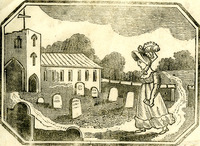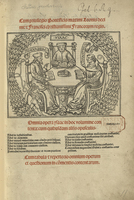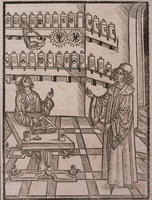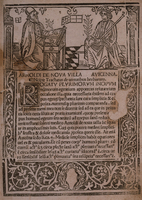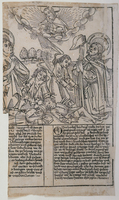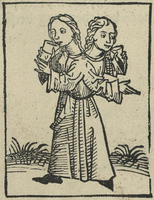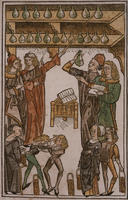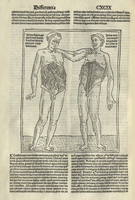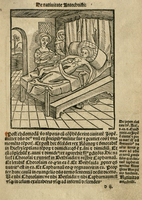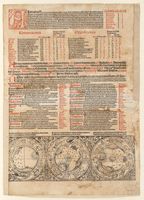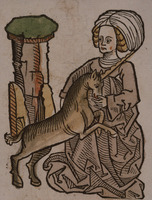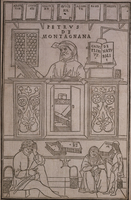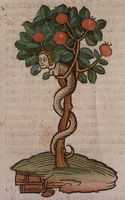Browse Items (20 total)
- Tags: woodcuts
Sort by:
A copy of verses on the horrid murder of a little girl at Longden in Shropshire, by a man named Mapp
The John Rathbone Oliver Criminological Collection includes a number of popular English broadside ballads commemorating murders, rare trials, and executions as part of Oliver’s interest in psychiatry and criminal motivation. Catherine Lewis, a…
The book of knowledge, treating of the wisdom of the ancients in four parts
Editions of The book of knowledge, a popular astrological and medical work, begin to appear in the 1530s and were printed regularly in England and America into the early 19th century. Although described on the title-page as “a Jew, Doctor in…
Anulus astronomicus
Bonet de Lates was a Provençal physician and astrologer who settled in Rome, where, in addition to acting as physician to Popes Alexander VI and Leo X, he served the Jewish community as a rabbi. He is best known for his invention of the…
Opera Omnia Ysaac
This first printed edition of the collected works of Isaac Israeli includes the tract on fevers. The title-page woodcut depicts an impossible meeting of Isaac with his eleventh century commentators Constantine the African and Ibn Abi al-Rijal.
Herbolarium de virtutibus herbarum
The Herbolarium describes the medicinal uses of common herbs and plants with woodcut illustrations of each. The work was once attributed to the medieval physician Arnaldus de Villanova (d. 1311) because of this imaginative frontispiece depicting a…
Pestblatt
This broadside sheet was printed during an epidemic of plague in the German city of Augsburg in the early 1470s. The woodcut depicts Saints Sebastian and Roch (accompanied by an angel), comforting those struck down by the plague. Prayers to the two…
Lines of the hand and their associated zodiac symbols
Chiromancy or palmistry is the study of the lines and shapes of the human hand to determine an individual's characteristics and analyze past, present, and future events. Books on the subject were among the most popular incunables produced. This brief…
Ein hubscher Tractat von dem Ursprung des Bösen Franzos
This small pamphlet on syphilis [A Fine Treatise on the Origin of the French Evil] was enormously popular, appearing in four different editions in Latin and German in the last years of the fifteenth century. The pamphlet was printed during the course…
Das Buch der Cirurgia
Brunschwig's Book of Surgery was intended to be a manual of general practice for the independent surgeon and is the first printed German text on this subject. The Cirurgia contains information on the treatment of wounds, dislocations, fractures, and…
Das Buch der Croniken und Geschichten
The first German edition of Hartmann Schedel's famous Nuremberg Chronicle traces the history of the world through six ages, from the Creation to 1493, concluding with the Apocalypse. Michael Wolgemut and Wilhelm Pleydenwurff designed maps, city…
Hortus sanitatis
The Hortus sanitatis [Garden of Health] was a popular compendium of plant and herb lore during the Middle Ages. This is the first Latin edition, and twenty others were printed in Latin before 1547 attesting to its popularity. In addition to botanical…
Fasciculus medicinae
Although notable as one of the first incunables acquired by the Boston Medical Library, this first edition of the Fasciculus medicinae is also a cornerstone in the history of medicine, as it contains the first detailed anatomical illustrations ever…
Conciliator differentiarum philosophorum et medicorum
The thirteenth-century Italian scholastic, Petrus de Abano, translated Hippocrates, Galen, and many other classic Greek medical texts into Latin. His major work, the Conciliator differentiarum [Reconciler of the Differences Between Philosophers and…
De revelatione facta ab angelo Beato Methodio in carcere dete[n]to
This book of prophecies attributed to the fourth-century martyr, Methodius, was probably composed by a fifteenth century monk, Wolfgang Aytinger, to arouse animosity between Christians and Muslims. Although not specifically medical, the De…
Almanach ad annum 1494
Almanacs were used to record the most propitious days and times for purging, bloodletting, and pharmaceutical manufacture according to astrological and astronomical events. This specimen for the city of Erfurt in 1494 includes woodcuts depicting…

